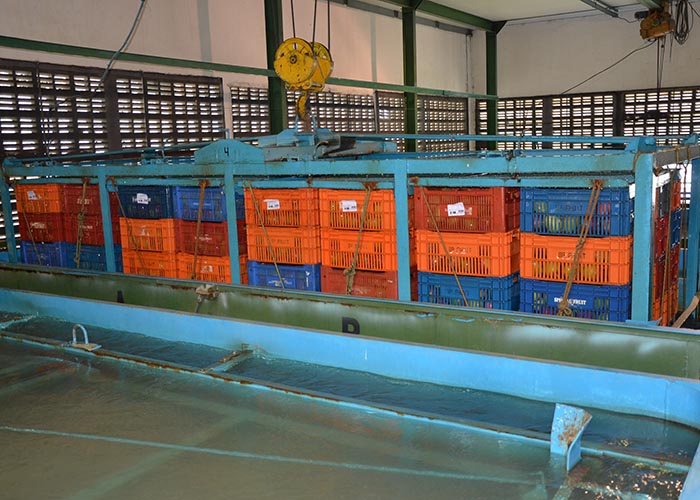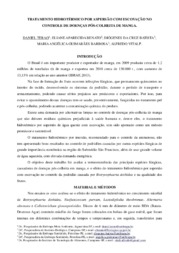Technology makes Brazilian mango exports to South Africa possible
Technology makes Brazilian mango exports to South Africa possible
Photo: Fernanda Birolo

Method consists in diving the fruits in warm water and does not use chemicals
In September, South Africa received the first batch of Brazilian mangoes. It comprised 25 tons exported after five years of negotiations. The transaction was only possible thanks to the fruits' hydrothermal treatment, a technology developed by a research network led by Embrapa for over two decades.
The obstacle had been imposed by decisions from the main fruit importing markets, which do not accept the application of chemical products to control fruit flies (Ceratitis capitata), one of the biggest threats to world fruit farming as it reaches different fruit types and varieties.
For long, Brazil only used chemical control to fight the pest, a practice that closed the doors of some international markets that adopt stern phytosanitary barriers.
Hot water and insect control
Developed at the early 1990s, the Brazilian technique was an adaptation of a fruit treatment used in other countries, like Mexico, and consists in diving fruits of up to 425 grams in water that is warmed at 46ºC for 75 minutes, and fruits between 426g and 650g, for 90 minutes. The process kills any insect eggs or larvae that may be present. The work of the Brazilian scientists was to develop parameters for national conditions and to fight fruit flies, since the technique was only used for other pests at the time.
Besides the hydrothermal treatment, the work recommended monitoring fly populations in the fields in order to inform the control made with chemical-free methods, such as the installation of traps in the orchard and other integrated pest management (IPM) techniques.
The success of the solution led to a new Brazilian model of phytosanitary certificate, which opened the markets of South Korea, Japan, Chile, Argentina, United States, the European Union and, recently, South Africa, to Brazilian fruits.
The research network responsible for the development of the technique is composed by specialists from Embrapa, the University of São Paulo Institute of Biosciences (IB/USP) and the biofactory Moscamed Brasil, under the supervision of the United States Department of Agriculture (USDA) and with the support of the São Francisco Valley Association of Vegetable, Fruit and Poultry Producers and Exporters (Valexport).
The valley of the fruitsThe region of the São Francisco river valley is the main fruit farming region of the country, especially the Tommy Atkins, Kent, Palmer and Keitt mango varieties. In 2009, due to their distinctive quality table grapes and mangoes, the National Institute of Industrial Property (INPI) gave it the Indication of Place of Provenance seal, which had been requested by the Council of the Lower Middle São Francisco River Valley Union of Associations and Cooperatives of Producers of Table Grapes and Mangoes (Univale). According to data from the Brazilian Association of Exporting Producers of Fruits and Byproducts (Abrafrutas), the São Francisco Valley is currently responsible for 90% of exported Brazilian mangoes and generates 200,000 direct jobs. “From January to September 2018, total exports of mangoes added up to US$ 93.43 million. Out of the 93,000 hectares planted in 2017, 35.630 hectares produce mangoes”, informs Eduardo Brandão, from Abrafrutas, who adds a curious fact: according to the pact established between Brazil and the United States, all packing houses in the Valley have the presence of an American technician to ensure the correct use of the technique. “Those who do not have a packing house rent a facility and pay for the service of the American technician. It is a high investment, but the amount paid by the United States, which is the largest consumer of national mangoes, makes it worth it”, he asserts. |
New markets
According to the president of the biofactory Moscamed Brazil, Jair Fernandes Virgínio, the hydrothermal treatment was fundamental so that the mango fruits reached the level of quality required to travel the world and open new markets. “The challenge imposed was major. Besides killing the eggs and the larvae, the protocol could not compromise the quality of the fruits and their shelf life. The strategy also considered the risk of infestation for the importing country. Another major concern was discovering the suitable temperature for the fruit size”, remembers.
A social organization recognized by Mapa and the Government of Bahia, Moscamed is the only one responsible for certifying, in all of Brazil, those who export mangoes produced in orchards with some level of fruit fly infestation to the United States. In the São Francisco Valley region, the company monitors 5.339 mango hectares with potential for exports weekly. The certification is only supplied to orchards with a Fly/Trap/Day (FTD) index that is lower than 1. “An FTD above 0.5 is a trigger and the property needs to use control measures”, Jair Virgínio states.
Solution for demanding markets
The executive director of the Brazilian Association of Exporting Producers of Fruit and Byproducts (Abrafrutas), the agronomic engineer José Eduardo Brandão Costa, ratifies the importance of the treatment. “It was the solution found in the sector to enter demanding markets such as the American one. Their highest concern was that, in the eight to ten days of transportation to the destination, there was a chance of the fruits bringing fly eggs or larvae”, he reports.
Endorsed by farmers, the treatment gained importance, especially due to the profit earning capacity. Frederico Costa, commercial director of Ibacem Agrícola, located in Curaçá, in Northern Bahia, talks about Embrapa's contribution in the research that culminated in the protocol. “Without it, it would not be possible to export mangoes to the United States, Japan, Chile and Argentina, markets that require the hydrothermal treatment, which was developed in partnership with exporters that have an interest in such markets”.
Using 900 collaborators during the peak of the harvest, Ibacem annually exports about 1.5 million boxes of the Tommy Atkins mango variety to the United States. “Moscamed undoubtedly provides an extraordinary service in the São Francisco Valley, making the technical-scientific monitoring and recommending treatments that are necessary in the field, so as to minimize problems in exports. Nothing can be done just empirically in an activity like ours, with the level of requirement of the fruit market. It is very important that growers are united and in line with Moscamed so that the fight against fruit flies is systemic, permanent, and not just occasional”, Frederico Costa asserts.
According to Tássio Lustoza Silva Gomes, executive manager of Valexport, an association established in 1988 that gathers about 70% of the region's exporters, the region has 40 mango exporters, but only ten use packing houses with structure for the hydrothermal treatment in the cities of Petrolina, in the state of Pernambuco, and Juazeiro and Casa Nova, in Bahia. “At the height of the harvest, there are 11 American inspectors overseeing the whole process. The rules are very similar for the United States, Japan, Argentina and Chile, however, we have some technical distinctions regarding the use of sensors as the hydrothermal treatment is performed, in addition, monitoring fruit flies is also necessary in many countries”, he states.
Four direct jobs per hectare
Valexport's data indicate that, on average, each property that grows mangoes in the region generates four direct jobs per irrigated hectare with the exports alone. At peak harvest, in the 6,000 hectares dedicated to exports, the total number of direct jobs borders on 24,000, and indirect ones, approximately 30,000.
The United States are the main individual consumer of mangoes from Brazil, with a particularitity: “The country only lags behind Germany, which is not the final consumer of the fruits sent there, as it is a distribution hub for the other countries of Europe”, Tássio Gomes remarks.
“We know that the South African market has a lot of potential, however, it is still early to talk about an annual export volume. So far there are four accredited companies and Abrafrutas has been working to increase this number. The first batch was sent by the company Argofruta”, Eduardo Brandão reports.
At the end of 2017, the Northeastern mango reached consumers in South Korea, one of the world's most demanding markets regarding food health and quality. According to the bilateral agreement, the Brazilian counterpart is to import fresh pears from the Asian country.
Considering the stages of generation and transfer between the years of 1987 and 2003, Embrapa estimated a total investment in the technology in R$ 2.4 million.
The hydrothermal treatmentDeveloped in accordance with the bilateral agreement on health and plant health between Brazil, through the Ministry of Agriculture, Livestock and Food Supply (Mapa) and the United States, represented by the country's Department of Agriculture (USDA), the work resulted in the PhD thesis by the researcher from Embrapa Cassava and Fruits Antonio Souza do Nascimento, entitled “Bioecological aspects and post-harvest treatment of fruit flies in mangoes”, at the University of São Paulo (USP). The research defined the combination of two techniques to control fruit flies: the populational monitoring and the hydrothermal treatment. In the fields, fruit fly monitoring before the harvest determines the population level of insects existing in the orchards. If necessary, crop control (measures that can affect the availability of food for the insects and reduce the incidence of the pest) and traps with organic products should be used. “The ideal is that mangoes reach the packing houses with minimal pest infestation, either as eggs or larvae”, explains Antonio Nascimento. In the packing house, the fruits are submitted to the hydrothermal treatment. “This technology was used in other countries, such as Mexico, but it did not encompass species of quarantine importance, which are Ceratitis capitata, Anastrepha oblique and A.fraterculus”, Nascimento reports, who is also professor at the Federal University of Recôncavo da Bahia (URFB). The experiments lasted three years and totalled 1,800 tests. “There were 200 for each fly species, multiplied by mango variety”, Nascimento recalls. “There was the need to synchronize the aging of different fruit fly species and the level of maturation of the different mango varieties. Such difficulties were mitigated because we could count on a good laboratory team and the financial and logistic support of Valexport and and of other mango growers”, he reports. |
Translation: Mariana Medeiros
Léa Cunha (MTb 1.633/BA)
Embrapa Cassava and Fruits
Press inquiries
mandioca-e-fruticultura.imprensa@embrapa.br
Phone number: +55 75 3312-8076
Further information on the topic
Citizen Attention Service (SAC)
www.embrapa.br/contact-us/sac/



